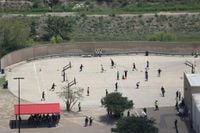In a dramatic turn of events over the recent Labor Day weekend, the Trump administration’s attempt to deport dozens of unaccompanied Guatemalan migrant children was halted by a federal judge, setting off a legal and humanitarian battle that has drawn national attention. The episode, which unfolded across several states and involved late-night government operations, has raised probing questions about the rights of migrant children, the responsibilities of the U.S. government, and the conditions that drive families to send their children north in the first place.
According to reporting by the Associated Press, the saga began on August 30, 2025, when the Trump administration abruptly notified shelters across the United States that unaccompanied Guatemalan minors in their care would be returned to Guatemala within hours. These children, many of whom had crossed the southern border alone, were living in government-run shelters and foster care, overseen by the Office of Refugee Resettlement under the Department of Health and Human Services. The shelters were told to have the children ready for immediate departure, with Immigration and Customs Enforcement contractors dispatched to collect them and transport them to airports in El Paso and Harlingen, Texas.
By the early morning of August 31, 76 children had boarded planes, poised to be sent back to Guatemala in what the government described as the first phase of a broader operation. The administration had initially identified 457 children for possible removal, though that number was later reduced to 327. The urgency and secrecy of the operation alarmed children’s advocates and legal organizations, who quickly mobilized to challenge the deportations in court.
Advocates argued that many of the children targeted for removal were fleeing abuse or violence in their home countries, and that longstanding legal procedures designed to protect young migrants were being bypassed. They maintained that returning these minors to Guatemala without proper review could expose them to further harm. As one advocate put it, the government was “bypassing longstanding legal procedures meant to protect young migrants from being returned to potentially abusive or violent places” (Associated Press).
Within hours of the operation’s launch, a federal judge in Washington, D.C., issued a 14-day temporary restraining order, largely preventing the Trump administration from removing the children in its care—except in cases where an immigration judge had already ordered removal after reviewing the child’s case. The order was a direct response to the emergency lawsuits filed by children’s advocacy groups, who had been tipped off about the planned deportations.
The legal battle intensified in the days that followed. On September 10, 2025, Judge Timothy J. Kelly held a hearing in which he pressed Justice Department attorneys about the government’s claims regarding parental consent. During the hearing, it emerged that a Justice Department lawyer had previously asserted that all of the children’s parents had requested their return to Guatemala. However, as Reuters reported, this statement was contradicted by a report from the Guatemalan Attorney General’s Office, which revealed that most parents of the approximately 600 Guatemalan minors in U.S. custody could not be located—and that many of the 115 parents who had been found did not want their children returned.
Judge Kelly cited this report during the hearing, prompting a government attorney to withdraw the earlier claim. As Lucrecia Prera, head of the Guatemalan Attorney General’s Office for Children and Adolescents, explained, Guatemalan authorities “regularly receive one or two unaccompanied minors per day from Mexico or the U.S., but had never been asked to accept as many as 100 at any given time” (Reuters). She also noted that most of the children the U.S. sought to return hailed from Huehuetenango, San Marcos, Quiche, and Alta Verapaz—regions marked by majority Indigenous populations, high poverty, and malnutrition.
The government’s rationale for the operation, according to court filings and statements from Guatemalan officials, centered on concerns about minors in U.S. custody who were approaching their 18th birthdays. Once these individuals turned 18, they would risk being transferred to adult detention facilities—a prospect that worried the Guatemalan government. Still, the sheer scale and speed of the attempted removals set off alarm bells, both in Guatemala and among advocacy groups in the U.S.
Many families in Guatemala had made extraordinary sacrifices to send their children north. Prera told Reuters that some had even mortgaged their homes to pay for the journey, hoping to secure a better future for their children. The prospect of forced return, without adequate legal review or parental consultation, struck many as a violation of both humanitarian norms and established legal protections.
In the days after the initial restraining order, children’s advocates pressed for even broader protections. They petitioned the Washington court to prevent the government from removing any children in its custody—with limited exceptions—while the lawsuit played out. Their request was spurred by reports that the administration might soon target Honduran children as well. Separate temporary restraining orders were also filed in Arizona and Illinois, though those cases covered a narrower group of children than the Washington case.
On September 13, 2025, Judge Kelly extended the temporary restraining order through September 16, citing the need for additional time to study the rapidly evolving facts of the case. The government, for its part, continued to argue that it had the right to return children in its care and that it was acting at the behest of the Guatemalan government. However, the revelations about parental consent and the conditions in the children’s home regions complicated the administration’s position.
Meanwhile, the children at the heart of the legal battle remained in limbo. Under current U.S. policy, unaccompanied minors who cross the border alone are transferred to the Office of Refugee Resettlement, where they typically live in a network of shelters until they can be released to a sponsor—usually a relative. The prospect of sudden deportation, however, left many children frightened and uncertain about their futures.
As the legal proceedings continue, the broader debate over immigration policy, humanitarian obligations, and the rights of children remains as heated as ever. The outcome of this case could set significant precedents for how the U.S. handles unaccompanied minors in the years to come, particularly in times of political and social upheaval.
For now, Judge Kelly’s order stands as a temporary safeguard, buying precious time for the courts to weigh the complex legal and ethical questions at stake. As advocates, government officials, and families on both sides of the border await the next decision, the fate of hundreds of vulnerable children hangs in the balance.




